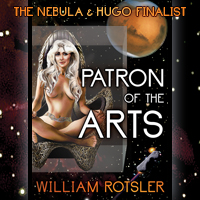Russell Letson reviews Jack McDevitt
Coming Home, the latest entry in Jack McDevitt’s long-running series on the adventures of antiquities dealer Alex Benedict and his pilot Chase Kolpath, also runs parallel plot threads: the search for a possible cache of very early space-age artifacts, and the attempts to rescue the passengers and crew of a starship caught in an anomalous hyperspace glitch. This latter thread connects directly to one of the series’ previous volumes, Firebird (reviewed in November 2011), which dealt, in part, with the mystery of disappearing – and sometimes reappearing – spacecraft that goes back to the beginnings of starflight. And in a move not unlike that of Starhawk (reviewed in January 2014), it looks backward to the series’ beginning.
The antiquities mystery begins when Alex is brought a very old item: a hyperspace transmitter from the very earliest period of interstellar travel. The oddest thing about it (aside from its survival across nearly nine millennia) is that the highly respected archaeologist who found it never told anyone about it but stuck it in a closet, where his family discovered it more than a decade after his death. This becomes part of the mystery: not only where did he find it, but why did he hide it away and never speak of it?
The lost-starship problem has a more personal connection to Alex and Chase: archaeologist Gabriel Benedict, Alex’s uncle and mentor and Chase’s former boss, was aboard the Capella when it went missing 11 years earlier with 2,600 passengers and crew. (This is also one of the precipitating events for the series’ first novel, A Talent for War.) Now the Capella has been sighted in normal, ‘‘linear’’ space, and it is estimated to be emerging for a few hours every five-and-a-half years. The central question is whether to try to rescue a few hundred passengers during each emergence phase or to attempt to stabilize the ship permanently. The passengers are experiencing only a few hours of ship time while they are out of linear space, so each partial off-loading process will add another five objective years of separation for those left aboard – but a failure of the stabilizing process might send the ship even farther out of synch with linear space, so disagreements over how to proceed complicate the already difficult problems of theoretical physics and rescue logistics.
The two story-lines connect thematically rather than via direct plot machinery. The series has always dealt with retrieving the past, but this volume offers much more detail about the various ways pieces of history go astray. The artifact-hunt looks back across the millennia, a view obscured by several Dark Ages and Times of Trouble, leaving swathes of lost history and vanished artifacts – and plain old facts. The Capella rescue effort faces a different temporal problem: the passengers are already 11 years out of synch with the world they left, and every transition to and from linear space pushes them another five-plus years into their future. General humanitarian issues aside, for Alex and Chase the return of Uncle Gabe, whose apparent loss was the genesis of their career together, could disrupt the business and their relationship.
The hunt for the source of the ancient transmitter follows some false trails and red herrings. A long-time critic of Alex’s business model goes missing – foul play? A boat taking Alex and Chase to the site of a submerged Space Museum is attacked and sinks. A curious reporter turns out not to be a reporter after all. But what’s a detective story without false leads and interviews that run into dead ends? The search takes the pair to all manner of interesting places on old Earth and in the home system (including a kind of asteroid suburb complete with a homeowners’ association) and offers opportunities to consider the Confederacy’s deep history.
In fact, while the novel’s framework is firmly linear and procedural (find the antiquities; rescue the Capella), I suspect that its heart is in those departures from (ahem) linear narrative space, as it ducks into and out of the murky, mysterious, half-recovered past of humanity’s spread to the stars. No other entry in the series has dealt so extensively with the details (or lack thereof) of the long, complicated, patchily documented span between the Golden Age (which begins with us) and the Rimway of 11,273 C.E. And while the achievements of those nine millennia are honored – especially those of the earliest space pioneers – it is the loss of information that resonates most strongly. Battles and crises, crashes and recoveries are known to have occurred, but details have vanished. Heroes have acted but their fates are unknown. Names but not contexts of real and fictional characters have survived. On visiting a museum with an especially strong collection of recovered ancient materials, Chase reflects on the fact that in the wake of the Dark Age and subsequent cultural brownouts,
[t]he vast majority of books, histories, classic novels, philosophical texts, were simply gone. Most of the world’s poetry vanished…. Just like almost every novel written before the thirty-eighth century…. Within a few generations of the electronic collapse, a few people knew Pericles had been important, but hardly anyone knew why….
Anyhow, that was the day I discovered why the term waterloo meant bad news. And how it happened that rubicon had something to do with a point of no return. And I’d always known what people meant when they called someone a Benedict Arnold. That day I learned why.
Only six Shakespeare plays survive. The Sherlock Holmes stories, ‘‘lost for six thousand years,’’ were rediscovered only 30 years ago; Tarzan is known to have ‘‘swung through jungles,’’ but is otherwise unidentified; Dracula, who ‘‘appeared in only one novel,’’ was ‘‘apparently a physician… associated with blood extraction.’’ Superman and Batman ‘‘got their start, we think, during the twenty- fourth century. Except for a brief period during the Dark Age, they’ve never gone away.’’
I have used the term ‘‘Vancean ramble’’ to describe Jack Vance’s tendency to depart from a linear-plot itinerary in favor of explorations of strange byways and exotic landscapes and folkways. Allow me to now propose the McDevitt ramble, which wanders through time more than space, rummaging around in the apparently empty areas of a deep past, retrieving objects and records, reconstructing lost stories, and filling in blank spots. It’s there as early as A Talent for War, and I wonder whether McDevitt has made his depiction of an interstellar polity 9,000 years from now so comfortably familiar (asteroid homeowners’ associations, remember) in order to make those Dark Age lacunae all the more strange, enticing, and poignant, and to remind us that even now we live in small pools of light in a vast dark.









